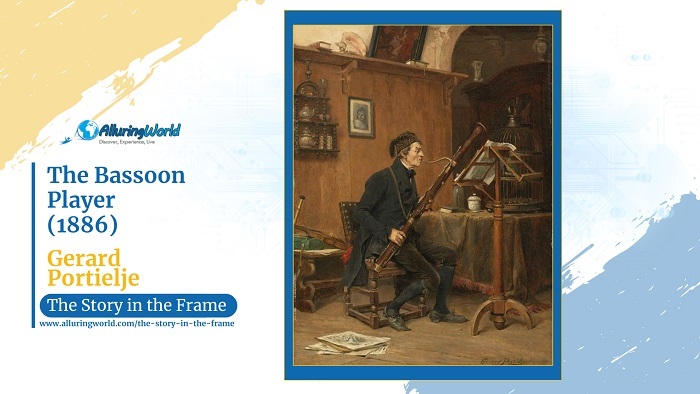Painted in 1886, The Bassoon Player is a charming and meticulously detailed genre painting by Belgian artist Gerard Portielje. Known for his ability to capture everyday life with warmth and humor, Portielje presents a scene that speaks to themes of education, dedication, and the value of music, and his work, influenced by 19th-century academic realism, brings a narrative quality to the depiction, making it both engaging and visually rich.
About the Painter:
Gerard Portielje (1856–1929) was a Belgian painter renowned for his genre scenes that captured the customs and social dynamics of the late 19th and early 20th centuries. Born into an artistic family, as his father, Jan Portielje was also a painter, he studied at the Royal Academy of Fine Arts in Antwerp, and his works often depicted domestic interiors, tavern scenes, and moments of interaction, emphasizing fine detail, warm colors, and storytelling elements. His paintings remain celebrated for their lighthearted yet insightful observations of human nature.
Inspiration and Reasons Behind the Painting:
Gerard Portielje likely found inspiration for The Bassoon Player in the vibrant street scenes of his time. The late 19th century saw a rise in depictions of working-class individuals and their various trades, and musicians were a common subject, so Portielje’s interest in capturing realistic scenes, combined with his skill in portraying human emotion, likely drove him to paint this intimate portrait. The painting may have been intended to celebrate the skill and dedication of these often-overlooked performers, or perhaps to simply capture a fleeting moment of beauty within the ordinary. It’s also possible that the painting was commissioned or intended for exhibition, where it would have resonated with an audience fascinated by realistic depictions of contemporary life.
What is Depicted in the Painting:
The painting is a captivating portrait that showcases the intricate details of a musician engrossed in his craft. The painting depicts a young man, likely a street performer, playing a bassoon, and as his face is illuminated by the soft light, it reveals a focused expression as he delicately manipulates the instrument. The artist masterfully captures the nuances of the musician’s posture, from the slight tilt of his head to the tension in his fingers as they navigate the complex fingerings. The vibrant colors and the play of light and shadow create a sense of intimacy and draw the viewer into the musician’s world.
Colors and Techniques:
Portielje employs a warm and rich color palette dominated by deep browns, golds, and soft reds, giving the painting a cozy and intimate feel. His technique is rooted in academic realism, with smooth brushwork and careful attention to textures, particularly in the detailed rendering of fabrics, furniture, and facial expressions. The use of chiaroscuro (the contrast of light and shadow) enhances the depth of the scene, drawing focus to the central figures and their interaction while subtly guiding the viewer’s eye through the composition.
Conclusion:
The Bassoon Player is a beautifully executed genre painting that tells a compelling and touching story. Through meticulous detail, expressive figures, and a warm atmosphere, Gerard Portielje captures a moment that resonates across time, the dedication people have, and the sacrifices made in pursuit of artistic dreams, and his work continues to be admired for its technical skill, narrative depth, and ability to bring the past to life with humor and humanity.

